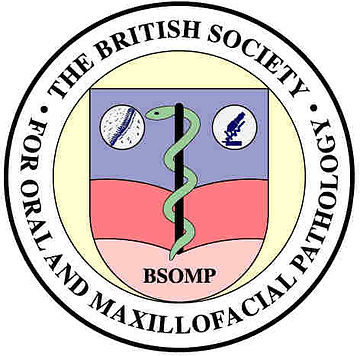society history & officials
What is Oral and Maxillofacial Pathology?
Oral and Maxillofacial Pathology is that part of pathology concerned with the scientific study of the causes and effects of disease in the oral and maxillo-facial complex, an understanding of which is essential for diagnosis and for the development of rational treatment and preventative programmes.
Aim of The British Society for Oral and Maxillofacial Pathology
The aim of the Society is to promote and encourage the study and practice of Oral Pathology and to facilitate communication between pathologists particularly those with an interest in oral, dental, maxillofacial & ENT diseases. The annual subscription is only £50 for Consultants and £25 for trainees and students.
Brief History of Oral Pathology
The first United Kingdom Chair in Oral Pathology was that created in 1944 in Newcastle and held by Robert Bradlaw although there had been two Chairs in Dental Surgery and Pathology in the 1930s. However, in 1892, there was a Chair in Oral Pathology and Surgery at the Dental College of Michigan, USA and in 1906, a Department of Oral Pathology was founded in Tokyo Dental College, Japan.
Brief History of the Society
The society evolved from an informal gathering known as the Oral Pathology Club. The inaugural meeting was held in Birmingham in September 1967 when 33 members met under the Chairmanship of Professor John Boyes. The group decided that the club should be informal with no written constitution. However, it soon became apparent that some guidelines on membership were needed and draft regulations were drawn up a year later.
In 1976, the Club was formally replaced by the British Society for Oral Pathology (BSOP); at that time, the Presidents were elected according to the venue for the Annual Scientific Meeting. In 1988, the constitution was amended to allow for a three year Presidential term of office. Potential nominees must be Members of the Royal College of Pathologists by examination.
The venue for the Annual Meeting continues to rotate around the country. In 1999 the name was again changed to the British Society for Oral and Maxillofacial Pathology (BSOMP) to properly reflect the nature of the specialty and to comply with the General Dental Council (GDC) list of specialties.
(For a full commentary on the political and scientific developments in Oral Pathology, see Oral Pathology 25 years on: The British Society for Oral Pathology Silver Jubilee Lecture. Kramer IRH. J Oral Pathol Med 1994; 23:49-54.)
Structure of The British Society for Oral and Maxillofacial Pathology
Currently, there are over 130 members of the Society; these comprise 1 Honorary Member, 17 Life Members and 94 Ordinary Members. Of these, 27 are overseas members.
The Society affairs are managed by a Council, which meets twice yearly; it comprises the Officers, Elected Councillors and Co-opted members.
The Officers of the Council are the President, Immediate Past President, President Elect, Honorary Secretary and Honorary Treasurer, the EQA organiser and a Juniors’ representative. In addition, there are three co-opted Councillors and one co-opted member who acts as the Specialty Adviser to the Royal College of Pathologists.
Current Council Members
CORE MEMBERS
PRESIDENT- Keith Hunter (Liverpool)
PAST PRESIDENT- Mary Toner (Dublin)
SECRETARY - Hannah Walsh (Sheffield)
TREASURER- Paris Tamiolakis (Guy's Hospital)
TRAINEE REPRESENTATIVE- Fatima Elmaghoub (London)
TEACHERS' GROUP CHAIR- Dan Brierley (Sheffield)
SACADS REPRESENTATIVE- Anne Chambers (Newcastle)
ELECTED REPRESENTATIVES- Lisette Collins (Guy's), Olyuri Adegun (UCL)
WEBMASTER- Jennifer Stahle (Dundee)
CO-opted MEMBERS
EQA REPRESENTATIVES- Adam Jones (Cardiff), Miranda Pring (Bristol), Timothy Bates (Bristol)
SAC Advisor RCPath- Gillian Hall (London)
FRCPath Chair of Panel of Examiners- Karwan Moutasim (Southampton)
Cellular Pathology SAC RCPath Representative (Head & Neck/ENT)- Phil Da Forno (Leicester)
Past Presidents
The British Society for Oral and Maxillofacial Pathology
2021-24- Dr Mary Toner (Dublin)
2018-21 Dr Bill Barrett (East Grinstead)
2015-18 Prof Paula Farthing (Sheffield)
2012-15 Prof PR Morgan (Guys)
2009-12 Prof P Sloan (Newcastle)
2006-09 Prof CD Franklin (Sheffield)
2003-06 Prof J Eveson (Bristol)
2000-03 Prof PM Speight (Eastman)
1997-00 Dr GT Craig (Sheffield)
The British Society for Oral Pathology
1994-97 Prof JV Soames (Newcastle)
1991-94 Prof RM Browne (Birmingham)
1988-91 Dr DG MacDonald (Glasgow)
1987 Mr KW Lee (Eastman)
1986 Prof JC Southam (Edinburgh)
1985 Prof RM Browne (Birmingham)
1984 Prof DM Chisolm (Dundee)
1983 Prof JR Garrett (King’s College, London)
1982 Prof FE Hopper (Leeds)
1981 Prof AS Prophet (UCL, London)
1980 Prof CJ Smith (Sheffield)
1979 Prof B Cohen (Royal College of Surgeons England)
1978 Prof AI Darling (Bristol)
1977 Prof RA Cawson (Guys)
1976 Prof JH Jones (Manchester)
Oral Pathology Club
1975 Prof DK Mason (Glasgow)
1974 Prof AEW Miles (The London Hospital)
1973 Prof BED Cooke (Cardiff)
1972 Prof I Rannie (Newcastle)
1971 Prof IRH Kramer (Eastman, London)
1970 Prof ED Farmer (Liverpool)
1969 Prof RB Lucas (Royal Dental, London)
1967-68 Prof J Boyes (Edinburgh)
BSOMP Logo
The top left circle of histology (inside the shield) is a drawing of odontogenic epithelium (done by Professor Chris Franklin). The right circle is a microscope. The top part of the shield (purple) is meant to represent the palate (with the uvula being the little dropped area in the middle), and the tongue is the bottom shape with a central groove (ligh pink). The middle section (dark pink) represents the mouth.
The snake on the cane is the Rod or staff of Asclepius to represent medicine and health (see below). The Caduceus has two snakes. In Greek mythology, the Rod of Asclepius, also known as the Staff of Asclepius (sometimes also spelled Asklepios or Aesculapius) and as the asklepian, is a serpent-entwined rod wielded by the Greek god Asclepius, a deity associated with healing and medicine. The symbol has continued to be used in modern times, where it is associated with medicine and health care, yet frequently confused with the staff of the god Hermes, the so-called Caduceus.




